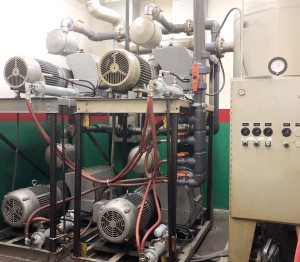Vacuum o-rings and seals play a critical role in compressors and UHV pumping. Choosing the right material is critical to ensure proper sealing. The key factors to look out for in material selection include permeability, modulus to deform into sealing surfaces, and outgassing from the rubber compound.
Proper groove design is also very important. Sealing surfaces need proper roughness, flatness and surface finish. Without this, rubber compounds will deform into uneven grooves, to some degree. The direction of machining grooves is important to assure a proper seal.
There are many factors of permeation in rubber compounds.
As discussed in a previous article, each rubber polymer base has a different permeation rate to different gases. Silicone has a high rate of permeability for air, while FKM or Viton™ have low rates. However, there may be some give or take based on the operating temperature range. FKM compounds typically perform worse in low-temperature applications. FKM will harden at a low temperature, causing deforming problems in groove imperfections. It’s important to always check the temperature range of any given rubber compound.
Deformation is critical in proper sealing.
To seal properly, o-ring materials need to deform into a seal groove. Modulus is a key function in determining how much deformation a rubber material will experience under different pressures. Rubber compounds typically range from 40 to 90 Shore A durometer. The lower the durometer the more deformation you will get. This is why low pressures call for lower durometers and higher pressures require higher durometers. This is critical in sealing applications because higher pressure sealing can blow lower durometer compounds out of the seal groove, causing leaks.
Outgassing of rubber compounds in vacuums.
Outgassing occurs when substances come out of rubber compounds while in a vacuum. These substances are typically low molecular weight oils or processing aids. Unused curative agents, like sulfur, can also outgas.
One standard test used for outgassing is ASTM E 595. To complete this test, NASA screening is done to find a total mass loss (TML) of less than 1.0% and a collected volatile condensable material (CVCM) of less than 0.1%. The outgas test is performed in a vacuum environment of less than 5 x 10-5 torr for a duration of 24 hours at 125’C. Our standard 75 durometer FKM compound as values of .28% TML and 0.01% CVCM. A 55 durometer FKM has values of .34% TML and 0.07% CVCM.
Vacuum grease can also be used to assist sealing.
These greases have low volatility and are used for low-pressure environments. Ultra-high vacuums or high temperatures may create problems in grease outgassing. Some examples of vacuum greases include Dow MOLYKOTE™ High-Vacuum Grease, KrytoxⓇ LVP (Krytox greases are typically chemically inert to different rubber polymers), and Apiezon L.
Apple Rubber design engineers can assist you in designing the proper groove, selecting the right material and seal design. Getting the right o-ring, custom rubber seal or gasket is critical to the overall performance of a vacuum seal.
